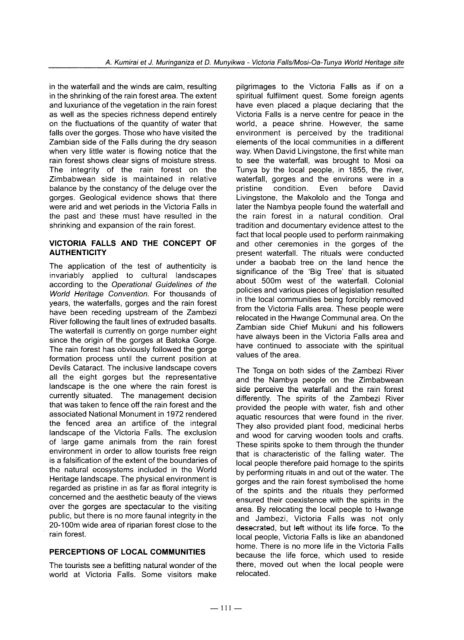Mul - unesdoc - Unesco
Mul - unesdoc - Unesco
Mul - unesdoc - Unesco
You also want an ePaper? Increase the reach of your titles
YUMPU automatically turns print PDFs into web optimized ePapers that Google loves.
A. Kumirai et J. Muringaniza et D. Munyikwa - Victoria Falls/Mosi-Oa-Tunya World Heritage site<br />
in the waterfall and the winds are calm, resulting<br />
in the shrinking of the rain forest area. The extent<br />
and luxuriance of the vegetation in the rain forest<br />
as well as the species richness depend entirely<br />
on the fluctuations of the quantity of water that<br />
falls over the gorges. Those who have visited the<br />
Zambian side of the Falls during the dry season<br />
when very little water is flowing notice that the<br />
rain forest shows clear signs of moisture stress.<br />
The integrity of the rain forest on the<br />
Zimbabwean side is maintained in relative<br />
balance by the constancy of the deluge over the<br />
gorges. Geological evidence shows that there<br />
were arid and wet periods in the Victoria Falls in<br />
the past and these must have resulted in the<br />
shrinking and expansion of the rain forest.<br />
VICTORIA FALLS AND THE CONCEPT OF<br />
AUTHENTICITY<br />
The application of the test of authenticity is<br />
invariably applied to cultural landscapes<br />
according to the Operafional Guidehes of the<br />
World Heritage Convention. For thousands of<br />
years, the waterfalls, gorges and the rain forest<br />
have been receding upstream of the Zambezi<br />
River following the fault lines of extruded basalts.<br />
The waterfall is currently on gorge number eight<br />
since the origin of the gorges at Batoka Gorge.<br />
The rain forest has obviously followed the gorge<br />
formation process until the current position at<br />
Devils Cataract. The inclusive landscape covers<br />
all the eight gorges but the representative<br />
landscape is the one where the rain forest is<br />
currently situated. The management decision<br />
that was taken to fente off the rain forest and the<br />
associated National Monument in 1972 rendered<br />
the fenced area an artifice of the integral<br />
landscape of the Victoria Falls. The exclusion<br />
of large game animals from the rain forest<br />
environment in order to allow tourists free reign<br />
is a falsification of the extent of the boundaries of<br />
the natural ecosystems included in the World<br />
Heritage landscape. The physical environment is<br />
regarded as pristine in as far as floral integrity is<br />
concerned and the aesthetic beauty of the views<br />
over the gorges are spectacular to the visiting<br />
public, but there is no more faunal integrity in the<br />
20-IOOm wide area of riparian forest close to the<br />
rain forest.<br />
PERCEPTIONS OF LOCAL COMMUNITIES<br />
The tourists see a befitting natural wonder of the<br />
world at Victoria Falls. Some visitors make<br />
- lll-<br />
pilgrimages to the Victoria Falls as if on a<br />
spiritual fulfilment quest. Some foreign agents<br />
have even placed a plaque declaring that the<br />
Victoria Falls is a nerve centre for peace in the<br />
world, a peace shrine. However, the same<br />
environment is perceived by the traditional<br />
elements of the local communities in a different<br />
way. When David Livingstone, the first white man<br />
to see the waterfall, was brought to Mosi oa<br />
Tunya by the local people, in 1855, the river,<br />
waterfall, gorges and the environs were in a<br />
pristine condition. Even before David<br />
Livingstone, the Makololo and the Tonga and<br />
later the Nambya people found the waterfall and<br />
the rain forest in a natural condition. Oral<br />
tradition and documentary evidence attest to the<br />
fact that local people used to perform rainmaking<br />
and other ceremonies in the gorges of the<br />
present waterfall. The rituals were conducted<br />
under a baobab tree on the land hence the<br />
significance of the ‘Big Tree’ that is situated<br />
about 500m west of the waterfall. Colonial<br />
policies and various pieces of legislation resulted<br />
in the local communities being forcibly removed<br />
from the Victoria Falls area. These people were<br />
relocated in the Hwange Communal area. On the<br />
Zambian side Chief Mukuni and his followers<br />
have always been in the Victoria Falls area and<br />
have continued to associate with the spiritual<br />
values of the area.<br />
The Tonga on both sides of the Zambezi River<br />
and the Nambya people on the Zimbabwean<br />
side perceive the waterfall and the rain forest<br />
differently. The spirits of the Zambezi River<br />
provided the people with water, fish and other<br />
aquatic resources that were found in the river.<br />
They also provided plant food, medicinal herbs<br />
and wood for carving wooden tools and crafts.<br />
These spirits spoke to them through the thunder<br />
that is characteristic of the falling water. The<br />
local people therefore paid homage to the spirits<br />
by performing rituals in and out of the water. The<br />
gorges and the rain forest symbolised the home<br />
of the spirits and the rituals they performed<br />
ensured their coexistence with the spirits in the<br />
area. By relocating the local people to Hwange<br />
and Jambezi, Victoria Falls was not only<br />
desecrated, but left without its life force. TO the<br />
local people, Victoria Falls is like an abandoned<br />
home. There is no more life in the Victoria Falls<br />
because the life force, which used to reside<br />
there, moved out when the local people were<br />
relocated.

















